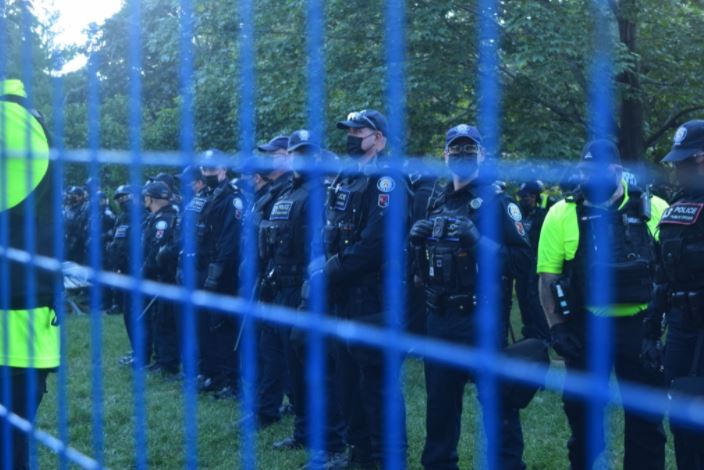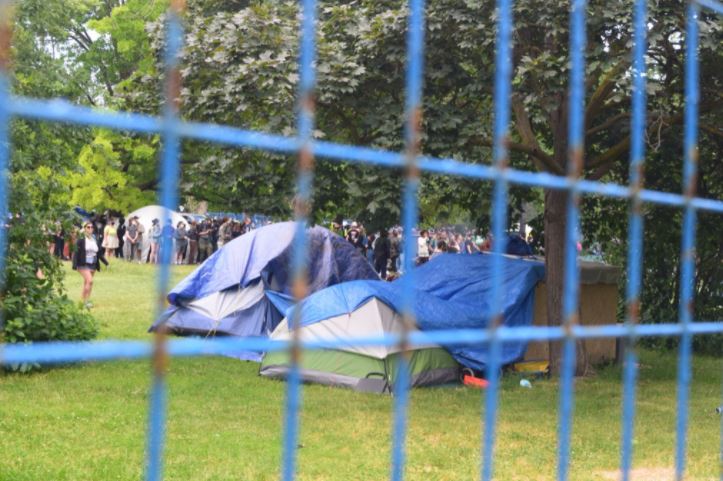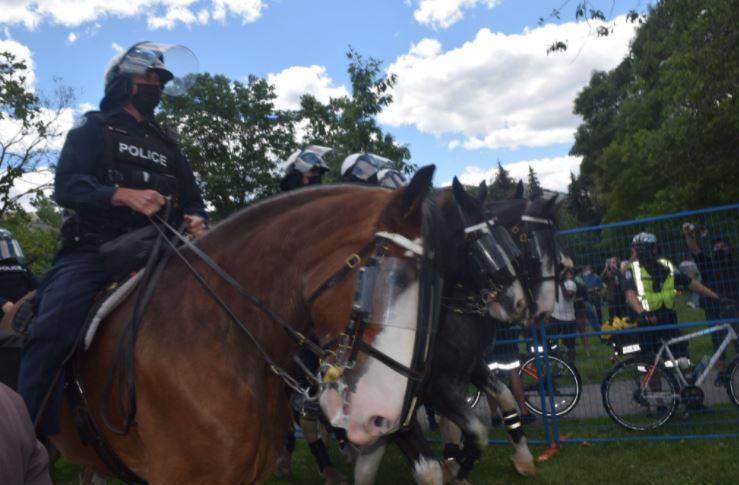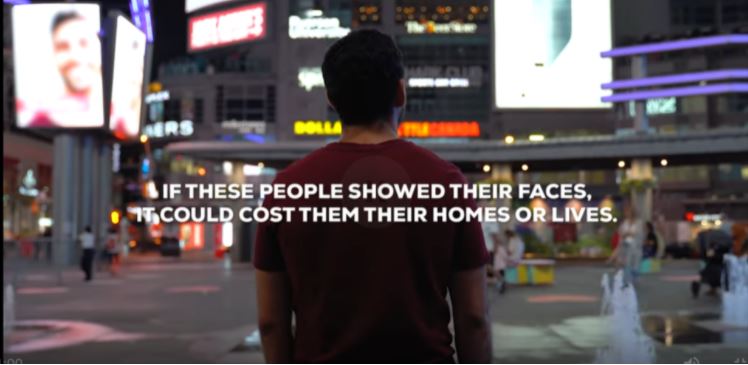It’s a good thing the City of Toronto is finally recognizing the challenges and the contributions of undocumented residents, but its actions – including three recent violent evictions of park encampment residents – belie its rhetoric, critics argue.
In partnership with FCJ Refugee Centre, Mayor John Tory declared August 24 “Undocumented Residents Day” as part of the City’s latest Toronto for All campaign, in order to “raise awareness around the tremendous hardships undocumented residents experience while living in fear due to their lack of immigration status,” according to a press release. It’s part of Toronto’s official status as a Sanctuary City, which technically allows everyone access to city services regardless of immigration status, a policy officially known as Access to City Services for Undocumented Torontonians (Access T.O.).

But Elene Lam, executive director of Butterfly: Asian and Migrant Sex Worker Support Network, notes that Toronto continues to be one of the cities with the greatest collaboration between police and the Canada Borders Services Agency (CBSA). Butterfly is a member of the Migrant Rights Network, a leading national grassroots network that employs direct action, research and popular education to combat racism and fight for migrant justice.
“The City of Toronto Police is one of the most frequent police [forces] to ask the immigration status of people,” she tells New Canadian Media.
There are no clear national data, but estimates of the number of undocumented people living in Canada range from 20,000 to 500,000, with about 50 per cent settling in Toronto.
According to No One is Illegal – Toronto, a grassroots group advocating for migrants and refugees’ rights regardless of status, between November 2014 and June 2015, Toronto Police Services called CBSA more than 3,200 times.
Lam says that hasn’t changed.
“Even when (undocumented people) call (police) complaining about domestic violence, the police call CBSA to arrest them,” she says.

This has direct effects on undocumented people’s access to basic but necessary services and rights such as health care and housing, and even their ability to safely work.
Precarious Work
For instance, Lam says over 100 undocumented massage parlour owners or operators (out of an estimated 2,000 workers in the industry) have contacted Butterfly saying they cannot renew their business licence because the city requires proof of immigration status. People whose temporary work permits have expired due to processing delays caused by the pandemic have been unable to renew their licence.
Migrant workers – particularly those with precarious immigration status – are also easy prey for exploitative employers. During COVID, exploitation of migrant workers has increased exponentially, according to a report from the Migrant Rights Network.
Lam says the City “should not create a barrier for not allowing people to work” by asking for immigration status.
In an email statement, Marcela Mayo, from the City’s media relations office, said that despite the city’s Sanctuary City moniker, “the City and businesses that operate in the city, are obligated to follow federal laws. This includes the Canadian Immigration and Refugee Act which regulates who is eligible to work in Canada, and issues work permits.”
She added that people experiencing pandemic related delays in work permit renewals “can inform the City and be granted an extension with their licence renewals.”
Institutionalized Homelessness
Undocumented people – and immigrants and refugees in general – also face systemic barriers to finding housing.
According to the Canada Mortgage and Housing Corporation (CMHC), in 2016, 26.6 per cent of recent immigrant-led households and 49 per cent of recent refugee-led households were in core housing need, compared to only 10.9 per cent of non-immigrant led households.
Being in core housing need means that a household “is considered unsuitable, inadequate or unaffordable,” and that its residents have no financial means to move somewhere adequate, according to Statistics Canada.
Affordability was the most common reason for falling into housing need, followed by crowding.
A 2008 report from COSTI Immigrant Services found that landlords routinely deny immigrants housing based on their colour, accent, perceived lack of resources and immigration status — a social ill known as “gate-keeping.”
The problem is even more pronounced given the “house crunch” and the pandemic, says Princie Sibanda, the author of the report and a senior policy analyst and social planner.
“Sometimes, it’s the gatekeepers that exploit immigrants more,” he tells New Canadian Media. Though it’s illegal, Sibanda says landlords are known to ask for even a full year’s rent in advance.
He suggests the Landlord and Tenant Board (LTB) should increase “enforcement in some of these immigrant enclaves to really consider…what sort of exploitation (newcomers) have to go through just to sustain a roof over their head.”
According to the Human Rights Legal Support Centre, in 2020-21, there was about a four percent increase in the number of housing discrimination calls they received, for a total of 2,117.
Such institutionalized barriers contribute to people losing their homes and having to turn to the streets or try to survive in the City’s already overwhelmed shelter system.
For immigrants, that represents extra challenges.
In his report, Sibanda notes that homeless immigrants and refugees “considered themselves constantly under scrutiny because of their status and had nowhere to turn to because they had no friends or community supports to turn to.”

A ‘Clear Contradiction’
According to Mayo, the “City has continually worked with individuals experiencing homelessness to ensure they have access to safe, indoor space” and that “immigration status is not a barrier to the City’s shelter system.”
But according to the City’s website, immigration status is a requirement to obtain Basic Need Allowance for shelter residents, to receive Financial Assistance from Ontario Works or Ontario Disability Support Program, to receive Housing subsidies (rental supplements/housing allowances), and to be put on the Social housing waitlist/Rent Geared to Income (RGI) Housing.
“There’s a clear contradiction there,” says Sibanda.
“We see a strong link there between inadequate and affordable housing, hidden homelessness, and immigration status. There’s a direct linkage there.”
While the regulation of the housing market falls outside of the City’s jurisdiction, municipalities play a crucial role in what happens to those who do fall through the cracks.
The 2008 report recommended politicians make housing a part of all immigration debates, “even if this involves a trade-off with the efficient operation of the market.”
That hasn’t happened, says Sibanda.
“It’s almost like housing is a separate issue,” he says. “What we need to do is to bring the housing issue to immigration policy debates and to discuss how immigrants are spatially distributed across Canada.”
Encouraging newcomers to “move out of the GTA” and into other communities where land exists to build affordable housing, including rural areas across Ontario, he suggested, “might actually help.”
‘Actual Policies’ Needed
What doesn’t help, Sibanda adds, is forceful evictions of homeless people trying to survive in park encampments such as the City-imposed ones that happened this past June and July at Alexandra Park, Trinity Bellwoods and Lamport Stadium, the latter of which saw the greatest police violence so far. A pending fourth eviction at Moss Park looms.
The United Nations says “(f)orced evictions constitute gross violations of a range of internationally recognized human rights, including the human rights to adequate housing, food, water, health, education, work, security of the person, freedom from cruel, inhuman and degrading treatment, and freedom of movement.”

Following the Trinity Bellwoods eviction, Tory defended the police’s actions, suggesting that had demonstrators allowed “the attempts the City was making to clean up these encampments,” police wouldn’t have reacted violently.
In her email statement, Mayo directed all questions about the police’s behaviour to the police.
Lam says “of course” those actions contradict the City’s rhetoric, adding that more education and training ——needed, not only for the public but for City staff, the Mayor, City Council and service providers.
Ultimately, she adds, if Undocumented Residents Day is to have any lasting effect on the lives of undocumented people, “actual policies” are needed beyond symbolic gestures.
“It’s a very important message, but they need to do the actual work,” she says. “Otherwise, we cannot see any actual change.”
Fernando Arce is a Toronto-based independent journalist originally from Ecuador. He is a co-founder and editor of The Grind, a free local news and arts print publication, as well as an NCM-CAJ member and mentor. He writes in English and Spanish, and has reported from various locations across Canada, Ecuador and Venezuela. While his work in journalism is dedicated to democratizing information and making it accessible across the board, he spends most of his free time hiking with his three huskies: Aquiles, Picasso and Iris. He has a BA in Political Science from York University and an MA in Journalism from Western University.





